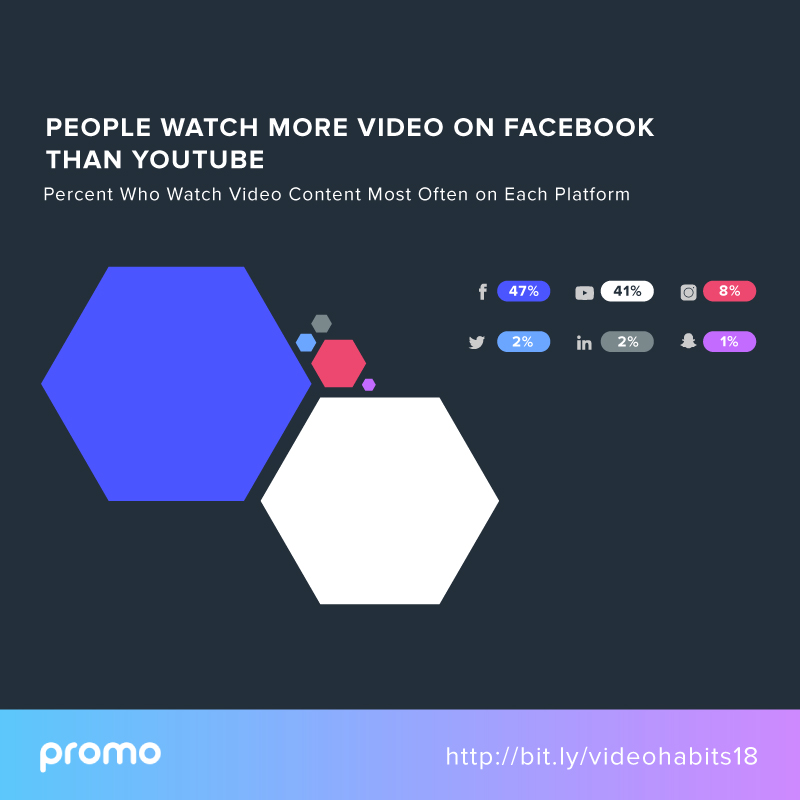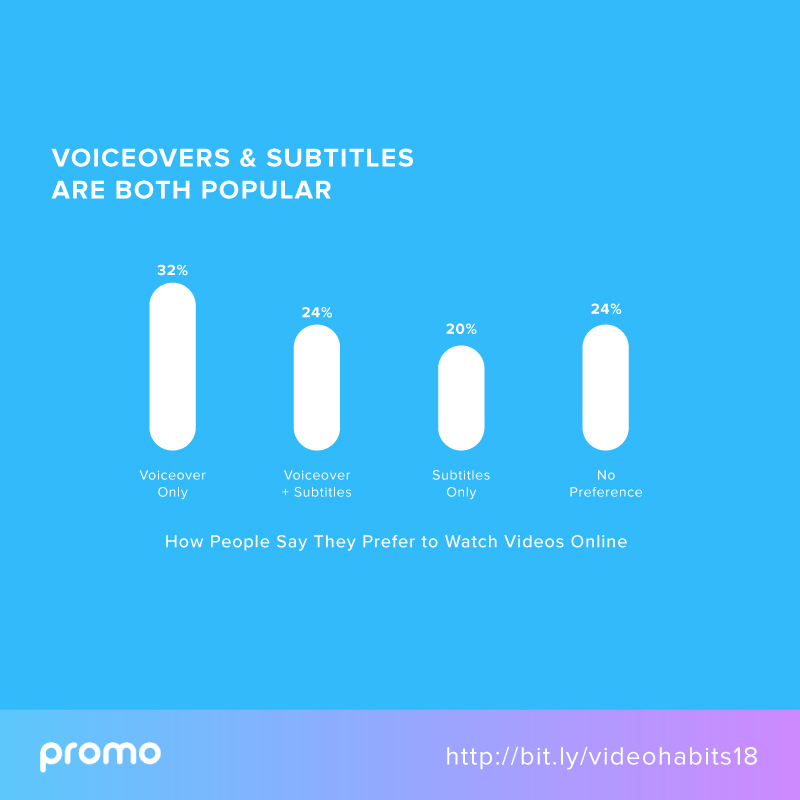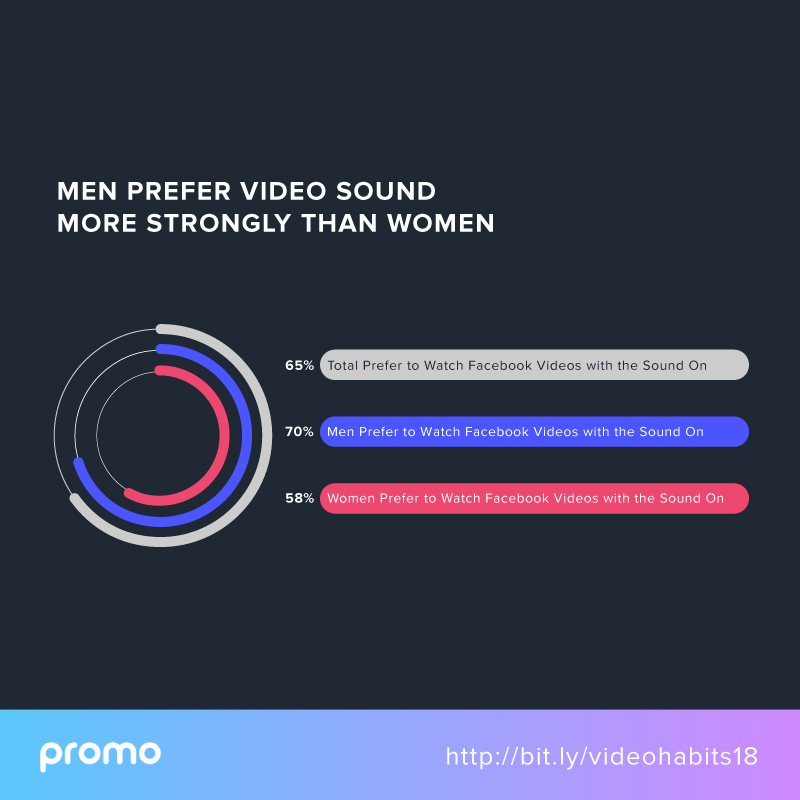The future of online marketing is video content.
It’s the leading format for brands and advertisers, and for good reason – consumers absolutely love video content. That’s why we decided to dig deeper to find out how, when, and where people prefer to watch videos online.
The team at PROMO conducted a study of more than 500 individuals of all ages.
We asked about their habits and preferences when it comes to watching online videos. As a result, we learned a lot about when and how people watch video, along with some powerful insights about consumer behavior that marketers can use to drive best practices and improve their business results.
The Value of Video Marketing
With the launch of FB Watch and IGTV, there’s no question that video marketing is bigger than ever. It’s not just that consumers like watching video – they’re watching a ton of it, daily.
According to our survey, 44% of consumers watch at least five videos online per day. That’s almost half of respondents watching more than five videos every single day. Even more incredibly, of those who watch five or more videos per day, about 35% say they watch more than ten videos online daily.
People enjoy watching and sharing video content so much that video marketing is the natural choice for businesses that want to widely distribute branded content.
Read More: Vertical Video is Spectacularly Misunderstood
Our study didn’t just confirm that people love video content, though.
We learned plenty about online video-watching habits, including these takeaways:
- Facebook is still the platform on which people spend most of their time.
56% of people spend most of their time on social media on Facebook, while 18% spend most of their time on Instagram. - 47% of people watch more videos on Facebook, while 41% do so on YouTube, and only 8% on Instagram.
- 71% of people said they find the sponsored videos on their Facebook feed to be “relevant” or “highly relevant” to them.
- Most people read the caption text above the video quite often. Only 10% said they rarely read the caption.
- 58% of people said they usually react to videos they watch online.
- 70% of people said they often visit the publisher’s website after watching a video.
- 60% of people said they visit the publisher’s Facebook page after watching a video.
Read More: Keeping up with Everyone’s Insatiable Appetite for Visual Content
We summarized these findings and the overall state of consumer video-watching habits in this infographic:

As interesting as all of these insights are, what are the biggest takeaways — and what do they mean in practical terms for marketers?
Let’s explore the trends in more detail.
Facebook and YouTube are Neck-and-Neck for Video Content

Read More: How Rewarded Video Ads Can Drive In-Game Purchases
Facebook and YouTube are clearly dominating the race for video content in 2018.
YouTube is now serving more than 1 billion hours of content every day. Meanwhile, in 2015, Facebook said its users were generating more than 8 billion video views every single day – a number that’s surely increased in recent years.
In our survey, users indicated that they are actually more likely to watch the majority of video content on Facebook compared to YouTube.
Of those surveyed, 47% say they watch videos most often on Facebook, compared to 41% who said YouTube. This is an interesting shift, marking Facebook’s success in transforming their platform to take advantage of the rise of online video.
For instance, Facebook has increased the reach and prevalence of native video content versus videos shared from other platforms (e.g., YouTube links). One study found that native video content receives, on average, 477% more shares and 530% more comments than videos posted to Facebook from outside platforms.
The recent algorithm changes seem to have tipped the scales in Facebook’s favor, making it the champion of video marketing in 2018.
Read More: 5 Reasons Video is the Best Choice for Account-Based Marketing
Stepping back to look at the broader trend,
No matter which way you slice it, the facts are clear: video is dominating as the most popular form of content across virtually every platform.
Marketers should take advantage of this trend by investing in video across social channels, but especially on Facebook. To get the most value from every piece of content, video created for one platform can (and should) be repurposed into the native format for other channels.
So, rather than sharing links to a YouTube video on Facebook or LinkedIn, it’s better to upload the video directly so you benefit from a boost in reach and engagement.
Instagram, Twitter, and LinkedIn are all lagging behind in terms of popularity, with just 12% of respondents saying they watch the majority of video content on any of these platforms combined.
Read More: Facebook Watch Is Competition For Publishers: Here’s What You Can Do About It
Videos and Sponsored Content Are Connecting in a Big Way
When asked, “How relevant do you find the sponsored videos that appear in your feed?,” a surprising 71% of consumer said they find sponsored videos relevant or highly relevant.
In light of this, it’s no surprise that video ads on Facebook have nearly doubled in popularity since 2015.
This is fantastic news for marketers because it confirms their paid social budgets are going to good use. Not only are consumers watching sponsored videos, but they’re are also finding them relevant (which is, of course, critical to successful marketing).
For marketers, this also points to the extreme importance of closely targeting the right users. Consumers have come to expect that sponsored social content be perfectly tailored to their lives and their interests.
Facebook and Instagram do an amazing job of curating videos to ensure the right people see your sponsored content. As long as you’re creating high-quality videos and targeting your audience correctly, people are likely to watch and engage with your videos.
Though some might view it as a downside that Facebook has moved to a mainly paid marketing model, the fact that sponsored video is actually resonating with viewers means the play-to-pay route may be still worth the cost. The key is to make sure you’re properly segmenting and targeting your audience.
Read More: The Trouble with Digital Advertising Agencies
Video Content Drives Action

It’s clear that social videos–especially on Facebook–are connecting with users. But are they actually driving tangible results or inspiring action from consumers?
The answer from our study is a resounding yes.
Over half of respondents (58%) say they react in some way to video ads online. More importantly, a huge portion of viewers take specific actions in response to video ads.
Amazingly, 70% of those surveyed said they sometimes or often visit a company’s website after seeing a video ad online. Additionally, another 60% visit a publisher’s page or profile after viewing a social video.
These results speak volumes about the power of video ads to drive direct responses from customers and consumers. It also underscores the importance of incorporating strategic video ads as part of your marketing mix – especially when paired with a compelling CTA that’s likely to translate into consumer action.
In fact, 89% of those surveyed say they read the accompanying text or caption on social media videos either “often” or “sometimes.”
The major lesson here? Social video is an effective tool for motivating consumers. Creating great video content isn’t just about getting likes or views, videos can drive traffic to your website or social page.
In fact, video may be the best format for inspiring modern consumers to take action.
Read More: For Brands, It’s Time To Start Paying Attention…To Attention
Viewers Prefer Sound, But May Need Subtitles
Another interesting finding from our study is that when watching a video on Facebook, 65% said they prefer to watch videos with the sound on.
However, Facebook data shows that approximately 85% of all videos viewed on their platform are actually watched without sound. (Note that Facebook counts a “view” as longer than three seconds spent watching a video, so simply scrolling past it in your newsfeed wouldn’t be counted in this measure.)
In addition, we found that nearly ⅓ of all respondents prefer to watch online videos with voiceover while just under ¼ prefer to watch with both voiceover and subtitles. About 20% of respondents say they prefer no voiceover–only subtitles–and another ¼ say they have no preference.
If we consider these insights together, we can see that although users have a strong preference for viewing videos with sound on, they might not always be in a position to do so. For instance, some viewers likely watch videos during their commute without sound to avoid disturbing those around them – even though they might prefer to watch with sound.

This suggests that marketers should create videos with both sound and subtitles in order to be accessible for the broadest audience in all circumstances.
Digging further into our survey results, we see an interesting difference in sound preference between men and women.

While approximately 70% of men prefer to watch videos on Facebook with the sound on, just under 58% of women indicated the same.
The Rise of Social Stories
Want to beat the social algorithm? Stories may just be your secret weapon.
Facebook and Instagram both adopted the concept from Snapchat and rolled out their own versions of “stories” on their platforms, allowing users to share and view time-restricted visual content. This functionality generally has its own place outside of the normal newsfeed and directly reaches all friends or followers.
Read More: What Type of Content is Best for Lead Generation?
In our survey, we found that 68% of respondents watch stories on Facebook or Instagram either “all the time” or “sometimes”.
Notably, only 52% of respondents say they post stories themselves. Since there are way more people viewing this content than those who are creating and sharing it, social stories could present a major opportunity for brands to get more views on a daily basis.
Lastly, the popularity of “stories” is especially high among millennial consumers, with 81% of respondents under age 34 saying they watch “sometimes” or “all the time.”
We can expect social channels to introduce even more new formats and styles for creating and sharing video content, which will open up exciting opportunities for brands to reach and engage customers online. As video continues to grow in popularity, companies that are already investing in video content will be best positioned to capitalize on emerging formats and channels.
About This Study
As the leading creative video provider for businesses, we decided to research popular online video-watching habits and uncover consumer preferences for viewing and engaging with video content.
We reached out to over 500 people worldwide to complete our survey.
To give you a bit more context for interpreting our results, here’s a breakdown of the survey respondents:
- Gender split was 41.51% female and 58.49% male
- Age range from teenage to senior (all ages)
- 8% were age 24 or younger
- 40% were ages 25-44
- 47% were ages 45 to 64
- 5% were over 65
- Android users accounted for about 48%
- iPhone users accounted for 51% (1% of respondents do not own a mobile phone)











